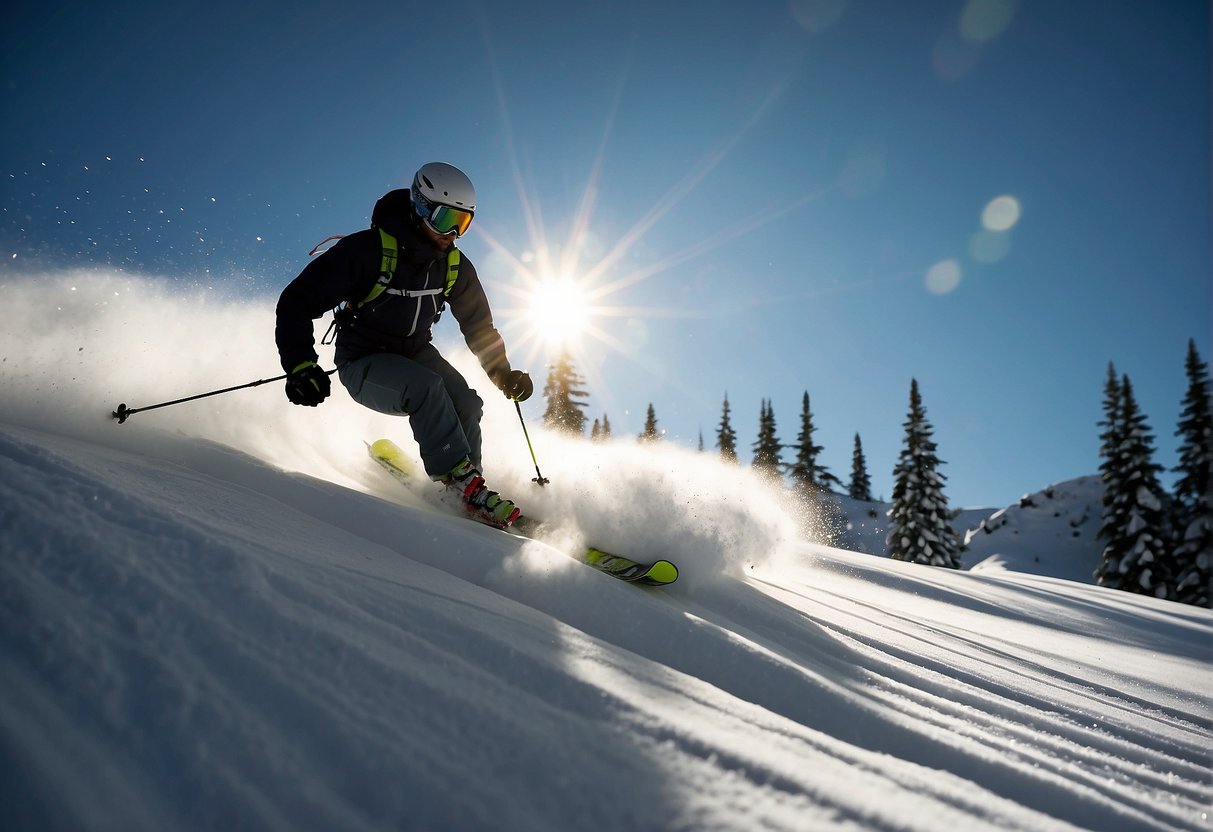📦 FREE Shipping
How Many Calories Does Downhill Skiing Burn 2024? Surprising Insights

Carving down the slopes is a thrill and a great way to torch calories. “How Many Calories Does Downhill Skiing Burn? Surprising Insights” slides into the energetic impact of this winter sport favorite.
How Many Calories Does Downhill Skiing Burn?
When skiing downhill, your body is a calorie-burning engine, and several variables tune the intensity of this burn. Your weight and the muscle groups influence the calories burned during skiing.
The more you weigh, the more calories you’ll expend. For instance, a 150-pound skier typically burns around 300 to 600 calories per hour, while a 200-pound skier might burn upwards of 800 calories per hour.
The intensity of your skiing session also plays a crucial role. A leisurely run down a gentle slope will burn fewer calories than aggressive skiing on challenging terrains. Moreover, age and fitness level affect your metabolic rate, which determines how efficiently you burn calories. Younger skiers with higher fitness levels usually have a faster metabolic rate, resulting in higher calorie burn.
Caloric Burn Comparison with Other Winter Sports
In winter sports, downhill skiing stands out for its calorie-burning potential. Cross-country skiing is another high-calorie burner, with a person weighing 180 pounds potentially burning about 772 calories per hour due to its continuous movement and higher MET (Metabolic Equivalent of Task) value.
On the other hand, a popular alternative like snowboarding also offers a significant calorie burn. Still, the exact numbers would vary based on factors similar to skiing, such as intensity and weight.
In short, if you aim to maximize your calorie burn, lace up your ski boots! The exhilarating rush of downhill skiing provides the sport’s joy and contributes significantly to your fitness journey. Get ready to hit the slopes and turn your day at the mountain into an effective full-body workout.
Health and Fitness Benefits of Downhill Skiing

Your core, quads, glutes, hamstrings, and calf muscles work in unison as you ski, improving strength and better balance. This integration of muscle action provides a full-body workout that can enhance your body composition.
- Core Muscles: Keeping you stable and steering
- Quads & Hamstrings: Powering your downhill movements
- Glutes: Propelling you forward
- Calf Muscles: Assisting in managing your skis
Each turn and maneuver requires effort, sharpening your endurance and amplifying your cardiovascular health. Downhill skiing can burn approximately 300 to 600 calories per hour depending on your weight and intensity, contributing to effective weight loss. Moreover, the sustained physical activity increases cardiovascular endurance.
The mental health aspect is just as exciting! The rush of endorphins from this dynamic workout boosts your mood. Regular exercise, like skiing, can be a cornerstone of keeping your spirits high and your health in check.
Practical Insights for Downhill Skiers

Optimizing Calorie Burn on the Slopes
To maximize calorie burn while skiing, consider your skill level, the terrain, and snow conditions. Beginners typically experience a higher calorie burn by engaging more muscles to maintain balance. As you improve, aim for more challenging terrains; steep slopes increase energy expenditure.
- Beginner: Roughly 500 calories/hour
- Intermediate: Up to 600 calories/hour
- Expert: Can exceed 600 calories/hour depending on intensity
Type of skiing and duration matter. Longer runs without extended breaks can keep your heart rate up, turning the slopes into a full-body workout. Riding the chairlift can offer a brief reprieve, but your body still works to stay warm against the chill.
Essential Gear for Effective Workouts
Your gear plays a pivotal role in ensuring your safety and the efficiency of your workout. Invest in quality:
- Boots: Ensure a snug, comfortable fit to improve control and reduce energy loss.
- Skis: Matched to your skill level and the terrain, well-maintained skis reduce unwanted drag.
Remember, the right clothing is also critical:
- Wear layers to manage body temperature.
- Use accessories like gloves and goggles for protection against the elements.
Preventing Injuries and Maintaining Safety
Downhill skiing presents the risk of injury, but you can minimize it with proper precautions. Injury prevention starts with warm-up exercises before hitting the slopes and cooling down afterward. Here’s a simple routine:
- Warm-Up: 5-10 minutes of dynamic stretching.
- Cool Down: Gentle stretching of major muscle groups.
Safety equipment is non-negotiable:
- Helmet: Always wear it to protect against head injuries.
- Pads: Consider wrist guards or knee pads for added safety.
FAQ:
How many calories does a full day of downhill skiing burn?
A full day of downhill skiing can burn between 2,000 to 3,000 calories, depending on your weight and intensity level.
Is skiing a good way to Lose Weight?
Yes, skiing is a good way to lose weight as it’s a high-energy activity that burns calories and builds muscle.
Is skiing a high calorie burning sport?
Skiing is a high-calorie-burning sport, with vigorous effort burning a significant amount of calories.
How many calories do you burn skiing for 30 minutes?
Skiing for 30 minutes can burn approximately 200-300 calories, again depending on your weight and the intensity of your activity.
If this article about the question: “How Many Calories Does Downhill Skiing Burn” helped you, don’t forget to leave us a comment down below about what you think of the article.

